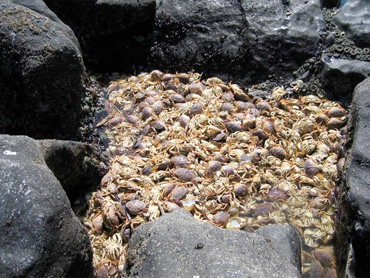In the summer and fall of 2006, large numbers of dead fish, crabs, and other organisms washed up on the beaches of Oregon and Washington. They had died of suffocation -- there wasn’t enough oxygen in the water to keep them alive. And the culprit could be our changing climate.
 Dungeness crabs washed up on the beach at Cape Perpetua, Oregon, after suffocating in the low-oxygen waters of a dead zone in 2004. Credit: National Science Foundation
Dungeness crabs washed up on the beach at Cape Perpetua, Oregon, after suffocating in the low-oxygen waters of a dead zone in 2004. Credit: National Science Foundation“Dead zones” like this are becoming more common. There are about 400 of them today, and the number is increasing every year. Most of them are created when rivers carry more fertilizers and sewage into the ocean. These nutrients create a chain reaction that consumes most of the oxygen at the ocean floor. The most famous dead zone in the United States is off the coast of Louisiana; more about that on our next program.
But in 2002, a new dead zone began to appear in the Pacific Northwest. And it has a different cause.
In summer, a combination of winds and Earth’s rotation push surface water away from the coast, allowing water that’s low in oxygen but high in nutrients to move in from greater depths. That spawns a “bloom” of microscopic plants at the surface. Later, the winds change direction, allowing the amount of oxygen in the water to return to normal.
In recent years, though, that last step hasn’t happened. Instead, the dead microbes have built up on the seafloor. They’re consumed by other microbes that use up the oxygen.
Some research says that’s the result of new circulation patterns in both air and ocean that are caused by global climate change -- change that could kill more marine organisms in the decades ahead.

